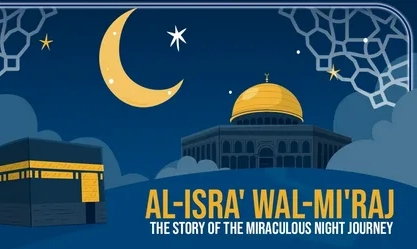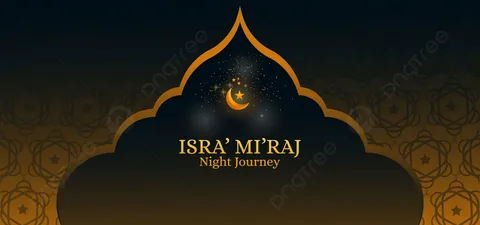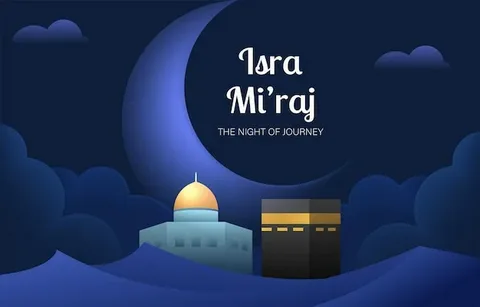Isra Wal Miraj, the miraculous night journey and ascension of Prophet Muhammad (PBUH), holds immense significance in Islamic history. This extraordinary event not only highlights the greatness of Allah’s power but also carries timeless lessons for humanity. As we reflect on this journey, we uncover What lessons can we learn from Isra Wal Miraj.
What is Isra Wal Miraj?

Isra Wal Miraj is a two-part journey undertaken by Prophet Muhammad (PBUH) in one night. The first part, Isra, involved his travel from Masjid al-Haram in Mecca to Masjid al-Aqsa in Jerusalem on the Buraq, a heavenly steed. The second part, Miraj, was his ascension through the seven heavens to meet Allah.
Quranic References
The story of Al-Isra (The Night Journey) and Al-Mi’raj (The Ascension) is an essential event in Islamic tradition. It recounts the miraculous journey of the Prophet Muhammad (peace be upon him) from Mecca to Jerusalem and his subsequent ascension to the heavens. The Quran references this event in two key places:
1. Surah Al-Isra (Chapter 17:1)
This verse explicitly mentions the Night Journey (Al-Isra):
“Glory be to Him Who took His servant by night from Al-Masjid Al-Haram to Al-Masjid Al-Aqsa, whose surroundings We have blessed, to show him of Our signs. Indeed, He is the All-Hearing, the All-Seeing.”
(Surah Al-Isra 17:1)
This verse describes the journey from the Sacred Mosque in Mecca (Al-Masjid Al-Haram) to the Farthest Mosque in Jerusalem (Al-Masjid Al-Aqsa), emphasizing God’s power and the blessing of this event.
2. Surah An-Najm (Chapter 53:13-18)
While Surah Al-Isra mentions the first part of the journey (the Night Journey to Jerusalem), these verses in Surah An-Najm are often interpreted as referring to the second part, the Ascension (Al-Mi’raj):
“And he certainly saw him another time, at the Lote Tree of the Utmost Boundary, near it is the Garden of Refuge, when there covered the Lote Tree that which covered [it]. The sight [of the Prophet] did not swerve, nor did it transgress [its limit]. He certainly saw of the greatest signs of his Lord.”
(Surah An-Najm 53:13-18)
These verses describe the Prophet Muhammad’s vision during his ascension to the heavens, where he beheld the Lote Tree of the Utmost Boundary (Sidrat Al-Muntaha) and other divine signs.
Prophetic Hadiths
The Night Journey (Al-Isra) and Ascension (Al-Mi’raj) are detailed in numerous Hadiths of the Prophet Muhammad (peace be upon him). These Hadiths provide a comprehensive account of what transpired during this miraculous event. Below are some of the key Prophetic Hadiths about Al-Isra wal-Mi’raj:
1. The Journey and Ascension
One of the most detailed narrations is from Sahih al-Bukhari:
The Prophet (peace be upon him) said:
“While I was at Al-Hatim or Al-Hijr (a part of the Ka’bah), lying down, someone came to me and opened my chest and took out my heart. Then a golden tray full of faith was brought to me, and my heart was washed and filled with faith, and then returned to its original place. Then a white animal, smaller than a mule and bigger than a donkey, was brought to me. It was called Al-Buraq. The animal’s step (was so wide that it) reached the farthest point within the reach of the animal’s sight. I was mounted on it, and it took me to Bayt Al-Maqdis (Jerusalem). There, I tied it at the same place where the Prophets before me had tied their animals. Then I entered the mosque and prayed two rak’ahs there, and then came out. Gabriel brought me a vessel of wine and a vessel of milk. I chose the milk, and Gabriel said, ‘You have chosen the Fitrah (natural disposition).'”
(Sahih al-Bukhari, Hadith 3207; Sahih Muslim, Hadith 162)
2. The Ascension through the Heavens
The Prophet (peace be upon him) narrated his ascension into the heavens and meetings with various prophets:
The Prophet (peace be upon him) said:
“Then Gabriel took me up to the nearest heaven and asked for it to be opened. It was asked, ‘Who is it?’ He said, ‘Gabriel.’ It was asked, ‘Who is with you?’ He said, ‘Muhammad.’ It was asked, ‘Has he been sent for?’ Gabriel said, ‘Yes.’ So, it was opened, and we went over the nearest heaven, and there we saw a man sitting with many people on his right and on his left. When he looked at his right, he laughed, and when he looked at his left, he wept. Gabriel said to me, ‘This is Adam, and those on his right are the people of Paradise, and those on his left are the people of Hell.'”
(Sahih al-Bukhari, Hadith 3207; Sahih Muslim, Hadith 162)
The Prophet went on to meet other prophets in the successive heavens:
- Second Heaven: Prophet Isa (Jesus) and Yahya (John).
- Third Heaven: Prophet Yusuf (Joseph).
- Fourth Heaven: Prophet Idris (Enoch).
- Fifth Heaven: Prophet Harun (Aaron).
- Sixth Heaven: Prophet Musa (Moses), who wept because a prophet with a greater following than his had appeared.
- Seventh Heaven: Prophet Ibrahim (Abraham), standing with his back against the Bayt al-Ma’mur (the heavenly Ka’bah).
3. Sidrat al-Muntaha and Divine Meeting
The Prophet (peace be upon him) described reaching the Lote Tree of the Utmost Boundary (Sidrat al-Muntaha):
The Prophet (peace be upon him) said:
“Then I was taken to Sidrat al-Muntaha, and its leaves were like the ears of elephants, and its fruits were like large clay jars. When it was covered by the Command of Allah, it changed, and none of Allah’s creation could describe its beauty. Then Allah enjoined fifty prayers upon my followers.”
(Sahih al-Bukhari, Hadith 3887; Sahih Muslim, Hadith 162)
4. Reduction of Prayers
One of the key moments during Al-Mi’raj was the reduction of the obligatory prayers from fifty to five:
The Prophet (peace be upon him) said:
“I returned to my Lord and asked for a reduction until He reduced them to five daily prayers. Then Allah said, ‘These are five prayers, and they are all (equal to) fifty in reward. What My Word changes not.’ So, I returned to Moses, but he kept asking me to go back to my Lord until I felt ashamed of repeatedly asking.”
(Sahih al-Bukhari, Hadith 3207; Sahih Muslim, Hadith 162)
Read more: What is special about 27 Rajab?
Spiritual Lessons from Isra Wal Miraj

The event of Virtues of the night of Al Isra wal Miraj is rich with profound spiritual lessons and insights for Muslims. It is not just a historical event but also a deep source of reflection, guidance, and inspiration for personal and collective faith. Below are some of the key spiritual lessons from this miraculous journey:
- The Importance of Salah: One of the most significant outcomes of this journey is the establishment of the five daily prayers. It emphasizes the centrality of Salah in a Muslim’s life, serving as a direct link between the believer and Allah.
- Strengthening Faith: Isra Wal Miraj reminds us to trust in Allah’s wisdom, even when His plans are beyond our understanding. The Prophet’s unwavering faith in delivering this message to his people, despite their skepticism, inspires us to hold firm in our beliefs.
- Overcoming Trials: The journey took place during a challenging time in the Prophet’s life, following the Year of Sorrow. It teaches us the value of patience and perseverance in the face of adversity.
Prophet Muhammad as a Leader: The journey highlights the qualities of a true leader—steadfastness, humility, and dedication to serving others. Prophet Muhammad’s interactions with other prophets and Allah reflect his pivotal role as a guide for humanity.
Empathy for the Ummah: The Prophet’s concern for reducing the number of daily prayers for his followers shows his immense compassion and empathy, a hallmark of great leadership.
Building a Connection with Allah
The Journey to the Heavens The Prophet’s meeting with Allah is a reminder that every believer has the opportunity to draw closer to their Creator through worship, supplication, and reflection. Developing a Personal Bond with Allah Muslims are encouraged to nurture a personal relationship with Allah by seeking His guidance and being mindful of His presence in their lives.
HOW Arabian tongue shapes your journey of LEARNing QURAN and arabic?
At Arabian Tongue, we empower you with the tools that allow for reflecting on the meanings of the Quran and sensing the greatness of the Creator. We incorporate unique teaching methods in our courses listed below:
- Learn Quran Online
- Online Arabic Classes
- Learn Tagweed Online
- Arabic grammar course online for beginners
- Quran Ijazah Course for Kids
FAQs
[sc_fs_multi_faq headline-0=”h2″ question-0=”What is the significance of Isra Wal Miraj?” answer-0=”Isra Wal Miraj signifies the greatness of Allah’s power and provides timeless lessons on faith, prayer, and perseverance.” image-0=”” headline-1=”h2″ question-1=”How does Isra Wal Miraj highlight the importance of Salah?” answer-1=”Salah was gifted during the Prophet’s ascension, emphasizing its role as the cornerstone of Islamic worship.” image-1=”” headline-2=”h2″ question-2=”What spiritual lessons can we apply from Isra Wal Miraj?” answer-2=”The event teaches us patience, trust in Allah, and the importance of personal growth through trials” image-2=”” headline-3=”h2″ question-3=”How can we strengthen our bond with Allah through this event?” answer-3=”By reflecting on Isra Wal Miraj, performing daily prayers, and seeking Allah’s guidance, we can deepen our connection with Him.” image-3=”” headline-4=”h2″ question-4=”Why is Isra Wal Miraj relevant in today’s world?” answer-4=”Its lessons on faith, unity, and resilience provide practical guidance for overcoming modern-day challenges.” image-4=”” count=”5″ html=”true” css_class=””]
Conclusion
Isra Wal Miraj is a profound event with lessons that transcend generations. It teaches us about the power of faith, the importance of prayer, and the beauty of submission to Allah’s will. By reflecting on this journey, we can strengthen our relationship with Allah, enhance our understanding of leadership, and foster unity within our communities.


